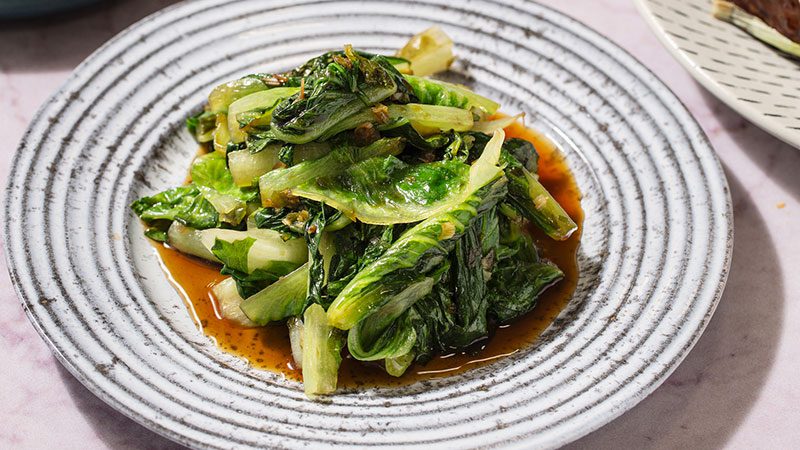Feasts of Good Fortune
Keeping holiday traditions alive
By Hsiao-Ching Chou and Meilee Chou Riddle, guest contributors

Photos by Clare Barboza
Traditions need keepers. Without the oxygen of intention and active practice, the ways we breathe life into culture, rituals, and celebratory foods gradually fade into slumber. I, Hsiao-Ching, have anchored on Lunar New Year as the marquee holiday where I pour my energy. The celebration is a core memory that I nurture for my kids and their cousins. How will they carry on this celebration? Will they carry it on?
I wonder how many Chinese holidays I’ve forgotten as I’ve grown older and fallen out of the rhythms of my late father’s nostalgia for a home he knew he would never see again. He’s been gone for nearly 20 years, but had been ailing for years prior. The community traditions he had kept began to lose steam when his health issues took priority. For my 82-year-old mother, retirement means the boundaries of calendar and clock time have softened. More than holidays, she’s now attuned to seasons by what trees or plants are blooming in her garden or along her walking path in the neighborhood.
If I don’t make an effort to keep up with the holidays, then they pass unacknowledged. One of the reasons I wanted to write my newest cookbook, Feasts of Good Fortune, was to highlight some major Chinese holidays throughout the year paired with a collection of recipes for foods we might serve to mark those moments. Another goal was to give space to an intergenerational conversation about what it means to share and receive the cultural stories, recipes, and traditions connected to those celebrations.
So it was essential to me that my teenage daughter, Meilee, be my co-author. I wanted her generation’s voice to have representation in the stories. Lunar New Year has always been my favorite holiday, because it’s about new beginnings, going home, being with family, paying respects, warding off bad luck, and feasting on symbolic foods. But what does it mean to Meilee, her brother, Shen, and their cousins?
When the kids were in grade school, I’d bring lucky candy to their classrooms and talk about Lunar New Year traditions. For several years, we also participated in cultural nights as another way to engage students around the zodiac, calligraphy, how to use chopsticks, and many other topics. Once, we also set up a dumpling-making station, where kids could roll out dumpling wrappers, and then fill and fold them.
Having the kids teach their fellow students how to make dumplings helped them internalize the technique, and also provided an opportunity to talk about the bulbous shape of dumplings symbolizing gold ingots and a wish for good fortune at Lunar New Year.
My eldest nephew is in his twenties and off at college. He’ll text photos of Lunar New Year decorations in his dorm and the potluck feast that he and some of his Asian friends have in the shared kitchen. When we all gather at our home for the big celebration, everyone requests their favorite dish: spring rolls for Lucie, braised pork belly for Shen and Sadie, dumplings for Meilee and Fletcher, duck for Duncan, scallion pancakes for everyone.
The older kids now have significant others, so our table has expanded. Last year, when the non-Asian guests also received red envelopes filled with money, they were shocked and didn’t know what to do. Meilee assured them it’s tradition to give children red envelopes to wish them longevity and that they, as guests, also were included.
(In the spirit of inclusion, I now pass the proverbial pen to Meilee.)
When my mom asked me to co-author Feasts of Good Fortune, I felt both honored and apprehensive. For years, I’d watched her write late into the night, styling dishes for photos, and perfecting recipes. The thought of being part of that process felt overwhelming. But as she shared her vision for a book celebrating family, food, and tradition, I realized this is how I can help continue the traditions throughout my life.
Lunar New Year has always been my mom’s favorite holiday. It’s a celebration filled with meaning, intention, and memories she’s carried and created over decades. To her, it’s never just about the food or the red envelopes; it’s about the connections built across all the generations around the table. This is a lesson that lives deeply within me.
Growing up, Lunar New Year connected me to my family, our culture, and the sense of security that comes from knowing where I come from. As one of the older cousins in our family, I have always cherished sharing these Lunar New Year traditions and rituals with everyone. Construction paper lanterns on the wall, the warm aroma of braised pork belly wafting through the air, the shared laughter as we gathered around the table. These moments are the roots that ground and connect me even when life feels chaotic.
I am now officially an adult, and as I’ve grown older, I find myself wondering how I’ll continue to carry this all forward. As I’ve watched all of my friends move across the country and seen how quickly my life has evolved since graduating high school, I have accepted that traditions won’t stay the same, and that’s okay. They reshape and adapt, just as we do. The dumplings I have tried to make over the years were folded clumsily and filled unevenly, but that didn’t matter. Just like any tradition, what mattered was the connection: The act of sharing and passing on a piece of our story, even if the details weren’t perfect.
Even as our family evolves through college moves, new relationships, and shifting priorities, this celebration remains a constant no matter where we are in life. It’s a reminder that no matter how far we wander, we always find our way back to the same table. My mom’s question about whether we will carry these traditions forward isn’t a simple one to answer. The celebrations may look different over the years, but their core, the love, the connection, and security, will always stay the same.
In many ways, I’ve already begun to pass it on. Each year, more friends want to join the feast and celebration and experience what this holiday is all about. As our family, both chosen and blood-related, grows and new faces join the table, I realize that every Lunar New Year celebration is a chance to practice what we hope to preserve.
Hsiao-Ching Chou and Meilee Chou Riddle are the co-authors of Feasts of Good Fortune. Hsiao-Ching has written two previous cookbooks and also works in communications in the tech industry. Meilee is a college student and filmmaker, whose short film “Chou’s Buffet” won for best documentary in the 2024 Northwest High School Film Festival.

STIR-FRIED ROMAINE
Makes 4 Servings, Family Style
Lettuce symbolizes prosperity because the characters in Mandarin are homophones for the phrase “growing your fortune.” Romaine is great because it’s hardy enough to withstand stir-frying but still delicate to eat. Like any other stir-fried greens, romaine is most delicious when treated simply. If you want to spice this up, feel free to add chili sauce or fresh peppers to taste.
1 head romaine lettuce (about 1 pound)
1 tablespoon vegetable oil
2 to 3 cloves garlic, finely minced or crushed
1 tablespoon soy sauce
1 to 2 tablespoons water, as needed
½ teaspoon sesame oil
⅛ teaspoon white pepper powder (optional)
Cut the romaine in quarters lengthwise through the core. Cut out the core. Slice the quarters crosswise into pieces that are about 1½ inches wide. This doesn’t have to be exact. What’s important is that the pieces are relatively the same size.
Preheat a wok over high heat until wisps of smoke rise from the surface. Add the vegetable oil and garlic and stir for about 5 seconds. Be quick so you don’t burn the garlic. Add the lettuce and stir-fry for about 2 minutes, or until the leafy parts start to wilt and no longer look raw. Swirl in the soy sauce and stir. If the lettuce looks too dry, add 1 to 2 tablespoons water. Add the sesame oil and white pepper. Give it one last stir to combine. Turn off the heat and transfer to a serving dish.
MOM SAYS: All vegetables have moisture. Lettuces and other leafy greens tend to hold moisture that releases when you apply heat. But if the greens aren’t in their freshest state (maybe they sat in the fridge for a couple of extra days and have started to wilt), you may have to add a tiny bit of water to help the stir-fry.
Recipe from Feasts of Good Fortune
Looking for more recipe inspiration for the Lunar New Year? Discover the PCC archive of Foods for the Lunar New Year.
Click here